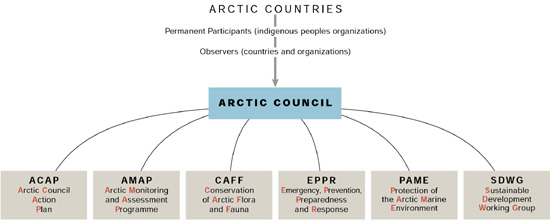Organisational Structure
AMAP is one of six working group that work under the direction of, and report to the Arctic Council.

AMAP was established in 1991 to implement monitoring and assessment components of the Arctic Environmental Protection Strategy. With the establishment of the Arctic Council in 1996, AMAP became a Working Group of the Arctic Council.
AMAP is responsible for monitoring and assessing the status of the Arctic region with respect to pollution and climate change issues; documenting levels and trends, pathways and processes, and effects on ecosystems and humans, and proposing actions to reduce associated threats for consideration by governments; and producing sound science-based, policy-relevant assessments and public outreach products to inform policy and decision-making processes.
| AMAP's members: |
|
|
|
The AMAP Secretariat is located in Tromsø
- Address: The Fram Centre, P.O. Box 6606 Langnes, N-9296 Tromsø, Norway
- Visiting address: Hjalmar Johansens gate 14, 9007 Tromsø
- Phone: +47 21 08 04 80
- Fax: +47 21 08 04 85
- E-mail: amap@amap.no
The Arctic Council's five other five working groups:
- Arctic Contaminants Action Programme (ACAP) responsible for increasing efforts to limit and reduce emissions of pollutants into the environment and promote international cooperation.
- Conservation of Arctic Flora and Fauna (CAFF) responsible for addressing conservation of Arctic biodiversity.
- Emergency Prevention, Preparedness and Response (EPPR) responsible for addressing various aspects of prevention, preparedness and response to environmental emergencies in the Arctic.
- Protection of the Arctic Marine Environment (PAME) responsible for addressing policy and non-emergency pollution prevention and control measures related to the protection of the Arctic marine environment from land and sea-based activities.
- Sustainable Development Working Group (SDWG) responsible for advancing sustainable development in the Arctic, enhancing the environment, economies, culture and health of Indigenous Peoples and Arctic communities, and improving the environmental, economic and social conditions of Arctic communities.
Click here for more information about other Arctic Council Working Groups.